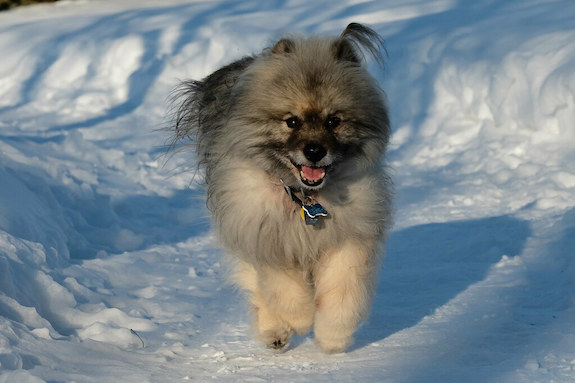
Agouti is one of the oldest and most common color genes in mammals. It can be found in deer, rodents and rabbits, and one main reason why it’s so common is that it provides excellent camouflage being, as it is, an overall grayish color with a brindled, or “salt and pepper,” appearance.
People who own agouti colored dogs know this coloration is due to each hair displaying two or more bands of pigmentation, or put another way, strands of fur that are banded. As the dog’s coat is growing, the cells first produce one type of pigment, usually eumelanin, so black/liver/blue/isabella pigment, then switch to another type, usually pheomelanin, or red. The gene that tells the cells to keep changing the pigment they produce is generally classified as aw. The “w” stands for “wild type,” the standard/common color that an animal occurs in, which in the case of wolves (and therefore dogs) is agouti.
As AnimalLabs.com explains it, Agouti encodes a paracrine signaling molecule which causes hair follicle melanocytes to synthesize reddish yellow pheomelanin instead of black or brown eumelanin, so-called pigment type-switching. Agouti signal peptide (ASIP) has several alleles that are involved in coat colour in dogs.
We’re not going to get into the genetics of agouti beyond what has already been mentioned, but we thought it worth mentioning that the word agouti, (and therefore, the description) comes from the coloration of several rodent species native to Middle America, northern and central South America, and the southern Lesser Antilles. They are of the genus Dasyprocta, and in dogs, the description refers to wolf-like “wild” color, the genes of which exist in five variants (alleles) coding different types of coloration. Indeed, dogs inherited this gene from wolves, and it’s seen especially in breeds that considered to be close to wolves, i.e., Czech Wolfdogs, Tamaskan Dogs, some German Shepherd dogs, a few Northern spitz-type breeds like the Keeshond and Elkhound, and others.
There are tests that can help breeders/owners determine the agouti alleles present in their dogs which can help determine possible coat color outcomes from specific matings; the University of California at Davis offers such a test that you can find here. There are also many wonderful sources that help explain agouti and other colorations, but our favorite has always been a site out of the UK, doggenetics which you can find here.
Image of a Keeshond by Chad Goddard shared under a CC BY-ND 2.0 license.
